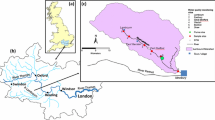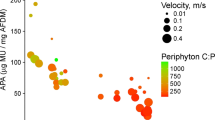Abstract
Periphyton stoichiometry can vary substantially as a result of differences in stream nutrient availability. A decrease in the periphyton carbon to phosphorus (C:P) ratio should decrease the demand for new P to be immobilized from stream water, but no studies to our knowledge have explored the relationship between periphyton stoichiometry and net P immobilization and release by periphyton. We sought to model biological P immobilization and release (flux) in streams by measuring periphyton stoichiometry and light availability. We measured P flux to and from intact periphyton on stream cobbles (20–100 mm diameter) in 1 L microcosms incubated with streamwater under variable light conditions. Net P immobilization occurred in 75% of microcosms, net P release occurred in only 5% of microcosms, and 20% of microcosms had neither net immobilization nor net release. When normalized to stream conditions, net P immobilization was highest when light availability was high (<60% canopy attenuation) and the periphyton C:P ratio was also high. In contrast, net P release occurred only when light availability was low (>60% canopy attenuation) and the periphyton C:P ratio was also low. A multiple regression model that included both periphyton stoichiometry and light availability from the growing season only, and the interaction term of these two variables, explained 99% of the variation in daily periphyton P flux observed in the study. These results indicate that in order to predict periphyton P immobilization, periphyton stoichiometry and light availability should be considered together. Furthermore, the results indicate that net P immobilization occurs even in very P-rich periphyton, which can act as a P sink when light availability is high.





Similar content being viewed by others
References
APHA (American Public Health Association) (2005) Standard methods for the examination of water and wastewater. American Public Health Association, American Water Works Association, and Water Environment Federation, Washington, DC
Borchardt MA (1996) Nutrients. In: Stevenson RJ, Bothwell ML, Lowe RL (eds) Algal ecology: freshwater benthic ecosystems. Associated Press, San Diego
Carpenter SR, Caraco NF, Correll DL, Howarth RW, Sharpley AN, Smith VH (1998) Nonpoint pollution of surface waters with phosphorus and nitrogen. Ecol Appl 8:559–568
Dodds WK (2007) Trophic state, eutrophication and nutrient criteria in streams. Trends Ecol Evol 22:669–676
Færøvig PJ, Hessen DO (2003) Allocation strategies in crustacean stoichiometry: the potential role of phosphorus in the limitation of production. Freshw Biol 48:1782–1792
Fanta SE, Hill WR, Smith TB, Roberts BJ (2010) Applying the light: nutrient hypothesis to stream periphyton. Freshw Biol 55:931–940
Frost PC, Elser JJ (2002) Effects of light and nutrients on the net accumulation and elemental composition of epilithon in boreal lakes. Freshw Biol 47:173–183
Gainswin BE, House WA, Leadbeater BSC, Armiage PD, Patten J (2006) The effects of sediment size fraction and associated algal biofilms on the kinetics of phosphorus release. Sci Total Environ 360:142–157
Godwin CM, Arthur MA, Carrick HJ (2009) Periphyton nutrient status in a temperate stream with mixed land-uses: implications for watershed nitrogen storage. Hydrobiologia 623:141–152
Hill WR, Rinchard J, Czesny S (2011) Light, nutrients and the fatty acid composition of stream periphyton. Freshw Biol 56:1825–1836
Hillebrand H, Kahlert M (2001) Effect of grazing and nutrient supply on periphyton biomass and nutrient stoichiometry in habits of different productivity. Limnol Oceanogr 46:1881–1898
Kahlert M, Hasselrot AT, Hillebrand H, Pettersson K (2002) Spatial and temporal variation in the biomass and nutrient status of epilithic algae in Lake Erken, Sweden. Freshw Biol 47:1191–1215
Liess A, Hillebrand H (2005) Stoichiometric variation in C:N, C:P, and N:P ratios of littoral benthic invertebrates. J North Am Benthol Soc 24:256–269
Lottig NR, Stanley EH (2007) Benthic sediment influence on dissolved phosphorus concentrations in a headwater stream. Biogeochemistry 84:297–309
Marti E, Sabater F (1996) High variability in temporal and spatial nutrient retention in Mediterranean streams. Ecology 77:854–869
Mulholland PJ, Newbold JD, Elwood JW, Ferren LA, Webster JR (1985) Phosphorus spiraling in a woodland stream: seasonal variations. Ecology 66:1012–1023
O’Brien PJ, Wehr JD (2010) Periphyton biomass and ecological stoichiometry in streams within an urban to rural land-use gradient. Hydrobiologia 657:89–105
Rogers CW, Sharpley AN, Haggard BE, Scott JT, Drake BM (2011) Physicochemical characterization of sediment in Northwest Arkansas streams. J Environ Prot 2:629–638
Rosemond AD, Mulholland PJ, Elwood JW (1993) Top-down and bottom-up control of stream periphyton: effects of nutrients and herbivores. Ecology 74:1264–1280
Scott JT, Back JA, Taylor JM, King RS (2008) Does nutrient enrichment decouple algal-bacterial production in periphyton? J North Am Benthol Soc 27:332–344
Scott JT, Lang DA, King RS, Doyle RD (2009) Nitrogen fixation and phosphatase activity in periphyton growing nutrient diffusing substrata: evidence for differential nutrient limitation in stream periphyton. J North Am Benthol Soc 28:57–68
Scott JT, Haggard BE, Sharpley AN, Romeis JJ (2011) Change point analysis of long-term phosphorus trends in the Illinois River (Oklahoma) demonstrate the effects of watershed management. J Environ Qual 40:1249–1256
Slaton NA, Brye KR, Daniels MB, Daniel TC, Norman RJ, Miller DM (2004) Nutrient input and removal trends for agricultural soils in nine geographical regions in Arkansas. J Environ Qual 33:1606–1615
Stelzer RS, Lamberti GA (2001) Effects of N:P ratio and total nutrient concentration on stream periphyton community structure, biomass, and elemental composition. Limnol Oceanogr 46:356–367
Sterner RW, Elser JJ, Fee EJ, Guildford SJ, Chrzanowski TH (1997) The light:nutrient ratio in lakes: the balance of energy and materials affects ecosystem structure and process. Am Nat 150:663–684
Townsend CR, Uhlmann SS, Matthaei CD (2008) Individual and combined responses of stream ecosystems to multiple stressors. J Appl Ecol 45:1810–1819
Walsh CJ, Roy AJ, Feminella JW, Cottingham PD, Groffman PM, Morgan RP (2005) The urban stream syndrome: current knowledge and the search for a cure. J North Am Benthol Soc 24:706–723
Wetzel RG (1993) Microcommunities and microgradients: linking nutrient regeneration, microbial mutualism, and high sustained aquatic primary production. Neth J Aquat Ecol 27:3–9
Withers PJA, Jarvie HP (2008) Delivery and cycling of phosphorus in rivers: a review. Sci Total Environ 400:379–395
Author information
Authors and Affiliations
Corresponding author
Additional information
Handling Editor: Hideyuki Doi.
Rights and permissions
About this article
Cite this article
Drake, W.M., Scott, J.T., Evans-White, M. et al. The effect of periphyton stoichiometry and light on biological phosphorus immobilization and release in streams. Limnology 13, 97–106 (2012). https://doi.org/10.1007/s10201-011-0359-z
Received:
Accepted:
Published:
Issue Date:
DOI: https://doi.org/10.1007/s10201-011-0359-z




